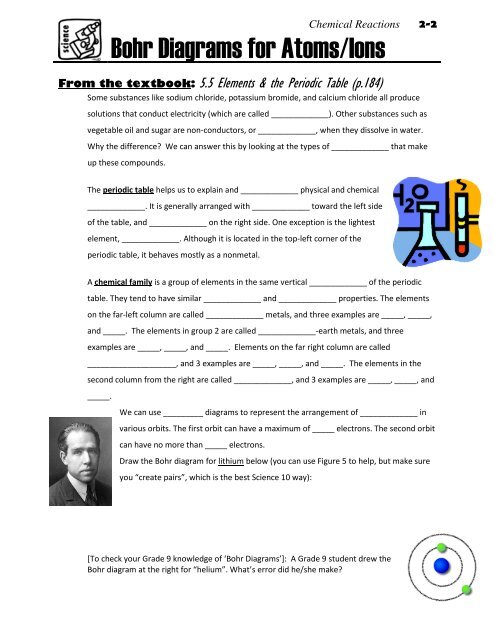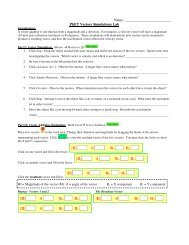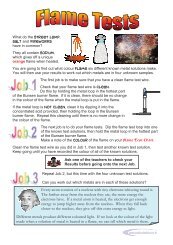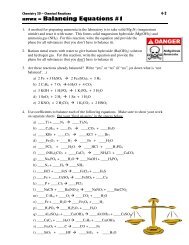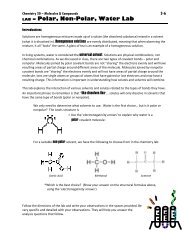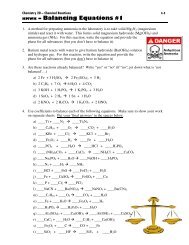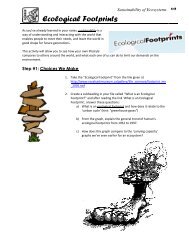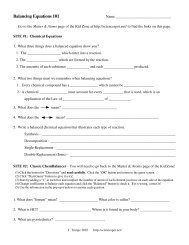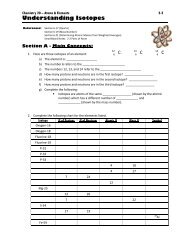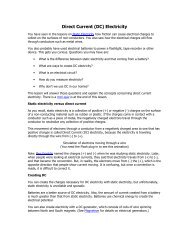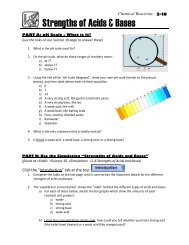You also want an ePaper? Increase the reach of your titles
YUMPU automatically turns print PDFs into web optimized ePapers that Google loves.
Chemical Reactions<br />
<strong>Bohr</strong> <strong>Diagrams</strong> <strong>for</strong> <strong>Atoms</strong>/<strong>Ions</strong><br />
2-2<br />
From the textbook: 5.5 Elements & the Periodic Table (p.184)<br />
Some substances like sodium chloride, potassium bromide, and calcium chloride all produce<br />
solutions that conduct electricity (which are called _____________). Other substances such as<br />
vegetable oil and sugar are non-conductors, or _____________, when they dissolve in water.<br />
Why the difference? We can answer this by looking at the types of _____________ that make<br />
up these compounds.<br />
The periodic table helps us to explain and _____________ physical and chemical<br />
_____________. It is generally arranged with _____________ toward the left side<br />
of the table, and _____________ on the right side. One exception is the lightest<br />
element, _____________. Although it is located in the top-left corner of the<br />
periodic table, it behaves mostly as a nonmetal.<br />
A chemical family is a group of elements in the same vertical _____________ of the periodic<br />
table. They tend to have similar _____________ and _____________ properties. The elements<br />
on the far-left column are called _____________ metals, and three examples are _____, _____,<br />
and _____. The elements in group 2 are called _____________-earth metals, and three<br />
examples are _____, _____, and _____. Elements on the far right column are called<br />
____________________, and 3 examples are _____, _____, and _____. The elements in the<br />
second column from the right are called _____________, and 3 examples are _____, _____, and<br />
_____.<br />
We can use _________ diagrams to represent the arrangement of _____________ in<br />
various orbits. The first orbit can have a maximum of _____ electrons. The second orbit<br />
can have no more than _____ electrons.<br />
Draw the <strong>Bohr</strong> diagram <strong>for</strong> lithium below (you can use Figure 5 to help, but make sure<br />
you “create pairs”, which is the best Science 10 way):<br />
[To check your Grade 9 knowledge of ‘<strong>Bohr</strong> <strong>Diagrams</strong>’]: A Grade 9 student drew the<br />
<strong>Bohr</strong> diagram at the right <strong>for</strong> “helium”. What’s error did he/she make?
When elements <strong>for</strong>m compounds, changes occur in the _____________ of<br />
electrons. In some compounds, electrons are _____________ from one atom to<br />
another, so that the atoms can have the stable electron arrangement of the<br />
closest __________________.<br />
As you can see in Figure 5 (and your drawing above), lithium has _____ electrons<br />
in the first orbit and _____ electron in the second orbit. If lithium (a metal) LOSES the electron<br />
in its outer orbit, it will look like this<br />
but it is no longer neutral; it has <strong>for</strong>med an _____________ (a charged atom in<br />
which the number of _____________ is different from the number of<br />
_____________). The charge of lithium is _____, because it has 1 more proton than<br />
electron.<br />
When calcium <strong>for</strong>ms a compound, from Figure 5 you can see that it has _____ electrons in the<br />
outer shell. If it should lose these electrons, it will <strong>for</strong>m an ion with a charge of ________<br />
because it has 2 more _____________ than _____________.<br />
Chemistry Ha Ha! [from the cartoon above]:<br />
Positive ions will _________________ negative ions.
Putting it Together: <strong>Atoms</strong><br />
1. Define the following terms:<br />
a) electrolyte<br />
b) alkali metal<br />
c) halogen<br />
d) valence shell<br />
2. How many protons are in these elements?<br />
a) titanium<br />
b) iron<br />
c) nickel<br />
d) radon<br />
3. How many electrons are in these<br />
elements?<br />
a) manganese<br />
b) uranium<br />
c) argon<br />
d) sulfur?<br />
6. Draw <strong>Bohr</strong> diagrams ( <strong>for</strong> these atoms:<br />
a) lithium<br />
b) neon<br />
c) sodium<br />
7. What did you notice about the number of<br />
electrons in the outer (last) shell of #6a,<br />
and #6c? What family do they both belong<br />
to on the periodic table?<br />
8. For question #6b, scientists say it has a<br />
“full outer (last) shell”. From your <strong>Bohr</strong><br />
diagram, why does that phrase make<br />
sense? Where would the next electron<br />
have to go?<br />
9. What element is this?<br />
4. How many neutrons are in these<br />
elements?<br />
a) sodium<br />
b) bromine<br />
5. In each of these, identify the element that<br />
has…<br />
a) 54 protons<br />
b) 19 protons<br />
c) 94 protons<br />
d) 1 electron
Putting It Together: <strong>Ions</strong><br />
10. From your <strong>Bohr</strong> diagrams you just finished in your notes, how would answer a Grade 9 student<br />
who asked you: “How do ions <strong>for</strong>m from atoms?”<br />
11. What three-letter suffix do all “negative ions” end with?<br />
12. Using your periodic table only, write the ions (with the correct charge) <strong>for</strong>:<br />
[note: the first one is done <strong>for</strong> you]<br />
a) magnesium ion<br />
b) chloride ion<br />
Ex/ Mg 2+<br />
c) nitride (nitrogen) ion<br />
d) oxide ion<br />
e) barium ion<br />
f) potassium ion<br />
g) aluminum ion<br />
h) phosphide ion<br />
13. How many electrons would there be <strong>for</strong> each of these ions?<br />
a) Pb 2+<br />
Normal atom: _______<br />
Charge:<br />
_______<br />
Total: _______<br />
b) As 3- Normal atom: _______<br />
Charge: _______<br />
Total: _______<br />
Use the same technique as a) and b) to answer these:<br />
c) Ti 3+<br />
d) Ra 2+<br />
e) Se 2-<br />
f) Mn 2+<br />
g) Br 1-


